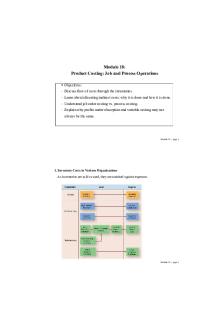Plppm 2013 - Lecture notes 18 PDF

| Title | Plppm 2013 - Lecture notes 18 |
|---|---|
| Course | Magical Mushrooms, Mischievouse Molds And More |
| Institution | Cornell University |
| Pages | 2 |
| File Size | 74.8 KB |
| File Type | |
| Total Downloads | 89 |
| Total Views | 152 |
Summary
Spring 2018, Prof. Hodge...
Description
PLPPM 2013 04/17 Gordon and Tina Wesson o “heroes of the magical mushroom world” o Tina was a Russian pediatrician o Gordon was a banker o Hobby to study mushrooms o Coined the terms: Mycophilia - love for mushrooms Mycophobia - the fear of mushrooms o Maria Sabina Shaman in Mexico Introduced Wasson’s to magic mushrooms o Wrote many books Explored the role of mushrooms in culture and history o Worked with Roger Heim French scientist who gave magic mushrooms Latin name Famous French mycologist Mushrooms stones of Guatemala Mayan mushrooms stones Mycologists Richard Evan Schultes - Harvard prof o studied cultural use of plants and some fungi o His graduate students continued his legacy Explored interaction of plants and fungi with spiritual practice and drugs Magical mushrooms often gives the sense of connectedness to the earth Many species o About 40 species have magical properties All belong to genus Psilocybe Little brown mushrooms with dark purple-brown spores o Most turn blue when bruised Life magazine article o Had a huge following o 1957 article about mushrooms that cause strange visions written by the Wassons The advocates o Timothy Leary o Entheogen Generating the divine within Refers to the spiritual properties of psychedelic drugs o Terence McKenna read an article about mushroom Terence McKenna and brother Dennis tried magical mushroom in 1971) Panspermia - life came from outer space? Believed it is an transformative factor in the early evolution of human consciousness
o “Stoned Ape theory” - proposed that our ancestors developed higher consciousness after they began eating magical mushrooms Science disagrees Effects: 1. Time slows down 2. Senses heightened (color, sound, movement) 3. Detachment from one’s physical “being” 4. “One” with the world 5. 2-6 hours Psilocybin is the active component of shrooms Low toxicity and low harm potential Lethal doses of the drug are rare Repeated use doesn’t lead to chemical dependency (not addictive) But, a single dose can change view of the world (could be therapeutic) The dark side: Cause panic attacks Existing schizophrenia can be triggered Don’t come back Easy to get in Amsterdam Netherlands: banned for tourists but didn’t ban sclerotia A legal loophole allows the sale of “magic truffles,” the sclerotia of magi mushrooms Psilocybin changed to Psilocin in body Psilocin (similar to serotonin) Temporarily alters the brain, rewires brain connections Least damage compared to other drugs Paul Stamets Lots of information about growing Psilocybe mushroom on the web - illegal under both federal and state laws, state 1 Can easily buy a spore syringe - not illegal because low level of detectable Recent bust in Brooklyn (over 250 pounds of illegal mushrooms) - 10 years in prison At the same time, advocacy groups fighting for rights to grow magic mushrooms Fallout Federal laws apply to chemicals made by the mushrooms Spores don’t contain these compounds but some states outlaw spores too (CA, GA, ID) If you start growing, you are a manufacturer Psilocybe cubensis (has ring around …., dark purple spore print Magic mushrooms look like Galerina contains deadly amatoxins; rusty brown spores, on wood Big laughing gym; rusty brown spore print, grows on wood Poisonous look-alike: glows in the dark Some things to consider...
Similar Free PDFs

Plppm 2013 - Lecture notes 18
- 2 Pages

Plppm 2013 - Lecture notes 17
- 2 Pages

18 - Lecture notes 18
- 5 Pages

Chapter 18 - Lecture notes 18
- 21 Pages

Chapter 18 - Lecture notes 18
- 14 Pages

Module 18 - Lecture notes 18
- 41 Pages

Chapter 18 - Lecture notes 18
- 26 Pages

Research 18 - Lecture notes 18
- 5 Pages

Chapter 18 - Lecture notes 18
- 13 Pages

Lecture notes, lecture 1-18
- 26 Pages

Chapter-18 - Lecture notes
- 5 Pages

Lecture 18 Notes
- 6 Pages

Lecture Notes 18
- 2 Pages

Lecture 16-18 Notes
- 7 Pages
Popular Institutions
- Tinajero National High School - Annex
- Politeknik Caltex Riau
- Yokohama City University
- SGT University
- University of Al-Qadisiyah
- Divine Word College of Vigan
- Techniek College Rotterdam
- Universidade de Santiago
- Universiti Teknologi MARA Cawangan Johor Kampus Pasir Gudang
- Poltekkes Kemenkes Yogyakarta
- Baguio City National High School
- Colegio san marcos
- preparatoria uno
- Centro de Bachillerato Tecnológico Industrial y de Servicios No. 107
- Dalian Maritime University
- Quang Trung Secondary School
- Colegio Tecnológico en Informática
- Corporación Regional de Educación Superior
- Grupo CEDVA
- Dar Al Uloom University
- Centro de Estudios Preuniversitarios de la Universidad Nacional de Ingeniería
- 上智大学
- Aakash International School, Nuna Majara
- San Felipe Neri Catholic School
- Kang Chiao International School - New Taipei City
- Misamis Occidental National High School
- Institución Educativa Escuela Normal Juan Ladrilleros
- Kolehiyo ng Pantukan
- Batanes State College
- Instituto Continental
- Sekolah Menengah Kejuruan Kesehatan Kaltara (Tarakan)
- Colegio de La Inmaculada Concepcion - Cebu

